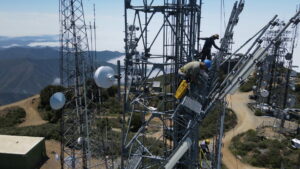We have just had an event that demonstrated something that I have been telling people for a while. An intense geomagnetic storm prompted many agencies to issue warnings of communications and power outages. Did you see any problems? We monitor the microwave, power, and internet links across our system, which includes Southern California, the Eastern Sierras, Nevada, and Colorado. We saw no effects.
Perhaps there was something somewhere, but overall, the impending disaster did not live up to expectations. My daughter had a dentist appointment and the X-ray machine malfunctioned. The receptionist (not the tech) was quick to mention the storm as a cause. However, it was nothing but a coincidence. I see posts from people still worrying that there will be some effect, but the peak has passed, so that is unlikely.
There are a few reasons that these predictions happen. One is that impending doom attracts more viewers than routine events. Another is that those making the predictions would like to take the credit if it comes true, and if it doesn’t, that will quickly be forgotten.

There is a part that is somewhat historical. In the beginning of radio the frequencies that we use today were hard to produce. The band names today reflect this. Your AM (540KHz to 1.6MHz) radio operates in what is called the Medium Frequency (MF) band, which is 300KHz to 3MHz. High Frequency spectrum (3MHz to 30MHz), also known as shortwave, was named such because it was higher frequency that what was previously used. Today these are considered to be very low frequencies. People listened to broadcasts from all over the world. There are many amateur radio (ham) and military allocations through this spectrum as well. These bands depend on atmospheric conditions to reach beyond the horizon. Radio waves are primarily line of site so when a solar storm changed the conditions in the ionosphere, long distance conditions could be disrupted.
Modern technology can produce much higher frequencies easily, so the Very High Frequency (VHF 30MHz to 300MHz) came in to use. Part of television is in the range. The FM broadcast band (88MHz to 108MHz) is here. There are amateur bands at 50MHz, 144MHz and 220MHz. Commercial two way radio at 40MHz and 150MHz. This progressed up in to Ultra High Frequency (UHF 300MHz to 3GHz) and Super High Frequency (3GHz to 30GHz). Cell Phones are located in the UHF and SHF bands. These frequencies interact with the atmosphere in a very different manner. Instead of being refracted by the atmosphere they tend to go straight though out in to space. For this spectrum long distances are accomplished by repeater stations located in line of site rather than depending on atmospheric conditions.
In this latest storm, the MF and HF conditions were affected, as they always have been, but how many people were actually listening there? Ham radio operators watch the solar weather reports, and choose frequencies to work the current conditions. If you like to listen to a distant AM or shortwave broadcast station, you might have noticed something wrong. However the vast majority of services are not in that frequency range any more.

Of course there is always the possibility of damage. We have had antennas damaged in snow storms. It is always possible for power to go out. Even the infamous EMP (ElectroMagnetic Pulse) happens more than people realize. Those possibilities are mitigated by construction standards and redundant systems. We have spare antennas on the towers as well as backup power sources. Surge arrestors, backup power and multiple repeaters are part of the standard build. For the EMP, lighting is a regular occurrence. Most people don’t realize that lightning is an EMP and while a nuclear weapon is a frightening concept, a very strong local pulse can be generated by a nearby strike. Lightning arrestors and grounds dissipate that pulse. For satellites, you can bet the guy designing one took conditions in space in to account so that the multi-million dollar package doesn’t just disappear in the next storm. Could it happen, sure. Sometimes there are events which exceed the expected design specs. Would everything be wiped out, unlikely.